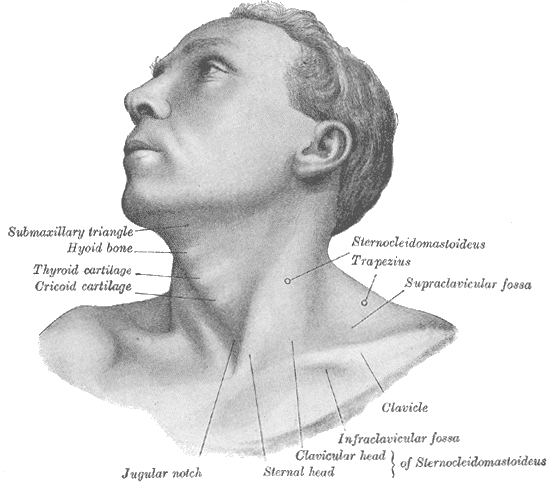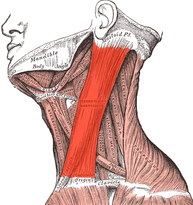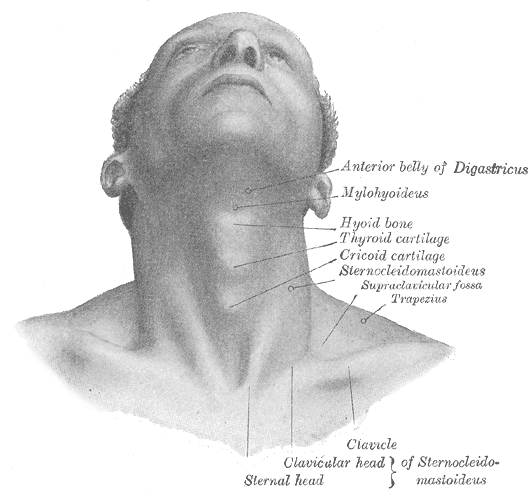CHRONIC NECK PAIN & THE SCM THE FIRST STEP TOWARD GETTING BETTER IS INCREASING THE NECK’S ABILITY TO MOVE
Head in forward posture can add up to thirty pounds of abnormal leverage on the cervical spine. This can pull the entire spine out of alignment. Forward head posture (FHP) may result in the loss of 30% of vital lung capacity. Would you be surprised that your neck and shoulders hurt if you had a 20-pound watermelon hanging around your neck? Rene Cailliet M.D., famous medical author and former director of the department of physical medicine and rehabilitation at the University of Southern California



There are about a million and one ways to end up with WHIPLASH, and after a quarter century in practice, I can assure you that I have seen many of them. One of the worst cases was in a 14 year old kid who had a chair (intentionally) pulled out from under him as he was sitting down in the school cafeteria. Regardless of whether your CHRONIC NECK PAIN is the result of CAR ACCIDENTS or other factors, the SCM muscle (Sterno-Cleido Mastoid) is almost always involved.
There are several things that happen when the SCM (as well as the PLATYSMA that covers it) has ADHESIONS OF THE FASCIA. One of the first is that it goes in to hyper-contraction or spasm. As you can gather from looking at the pictures above, this will draw the head downward (HEAD FORWARD POSTURE) or at the very least, prevent it from going backwards or side-to-side as much as it should. Not only is the FORWARD HEAD POSTURE associated with many bad outcomes (pain, ARTHRITIS, OSTEOPOROSIS, and even TYPE II DIABETES), so is the restricted motion that is almost always associated with it. It is critical to understand that DEGENERATIVE ARTHRITIS has a known cause — loss of normal joint motion.
Joints that do not move properly wear out prematurely, and as joints wear out, they move worse. As you can see, it is a vicious cycle that actually feeds itself. Listen to what Allen Woodruff said about Whiplash in an article he wrote for last year’s April 15 edition of Dynamic Chiropractic (The Illusive Root of Whiplash Associated Disorder).
“Unanswered questions surround whiplash, especially when no bones are broken. There is lack of evidence correlating speed, impact, size of vehicle, and severity of injury to chronic pain that shows up much later. A patient having fresh tissue injuries directly from whiplash unfortunately is a candidate for developing into a chronic sufferer, which can devastate their life. Most whiplash injuries begin with mild symptoms, but still pose an 18 percent chance of developing into chronic problems down the road, as much as two years following the initial injury.”
Considering how many people are or have been involved in Whiplash Accidents in the United States (not to mention the fact that evidence shows that nearly a quarter of these people will progress to chronic — even though many DID NOT SHOW IMMEDIATE PAIN), we need to be aware that by far, the most commonly affected muscle in such accidents is the SCM. When the SCM is injured, the pain is not only found at the muscle itself, but is far more frequently found in other sites. Some of the more common areas that pain is referred from the SCM include the sinuses, JAW, temple, eye, and even sometimes, the FACE. It is also one of the more significant contributing factors to HEADACHES — particularly headaches that originate at the base of the skull and radiate up to the top of the head — or even over to the eye area (a pattern like Lone Ranger’s mask). Furthermore, if a person is dealing with Neurological Symptoms that they know are not being caused by GLUTEN or GLUTEN-CROSS-REACTORS, then they need to look to the SCM. Some of the relatively common problems / symptoms associated with dysfunction of the cervical spine (neck) include things like Dizziness / Vertigo / Equilibrium Issues (HERE), Nausea, Visual Disturbances, Hearing Problems, and others. HERE is an example of the SCM and Cervical Spine Dysfunction causing a hearing problem (deafness) in a person who had absolutely zero neck pain. Listen to what CM Shifflett says in Surviving Martial Arts.
“When the SCM is strained or shortened the muscle itself rarely hurts, no matter how stiff or tight it may be. Problems are referred elsewhere, to head and neck, ears, eyes, nose and throat. The astonishing laundry-list of pain and dysfunction includes severe dizziness and other neurological symptoms. These may be mistakenly diagnosed as migraine, sinus headache, atypical facial neuralgia, trigeminal neuralgia, arthritis of the sternoclavicular joint, ataxia, multiple sclerosis (MS), brain lesions, tumors, and other frightening conditions. As always, these possibilities should be eliminated through differential diagnosis. However, because of its intimate relationship with the brain stem and several nerves including the vagus nerve, the SCM can produce many neurological disturbances all on its own. One is a condition known as “postural dizziness” — just walking around feeling dizzy and disoriented — perhaps with a frontal headache commonly interpreted as “sinus” pain.”
In the May 2010 issue of Minnesota Medicine, Neurologist and pain specialist Jack Hubbard (MD / Ph.D), talks about the bane of myofascial pain (TRIGGER POINTS & FASCIAL ADHESIONS) saying it is……
“quite common, especially in the cervical musculature, and most often found in patients 31 years to 50 years of age, with a greater incidence in women than men. Several studies have reported that up to 85% of back pain and 54.6% of neck pain and headaches are caused by myofascial pain.”
Did you catch that? The majority — over 50% —- of all back and neck pain is likely caused by problems in MUSCLES and FASCIA. Fascia is the single most pain-sensitive tissue in the body (HERE) and if you fail to understand that there are no drugs that aid in the healing process of soft tissues (there are many drugs that hinder this process — HERE is one such example), you are much more likely to end up with CHRONIC PAIN. There is one and only way to address these sorts of problems. It involves providing the body with SOLID NUTRITION (HERE is an example), while function, motion, strength, and muscular coordination are being restored.
Some of the things I use in my clinic include SCAR TISSUE REMODELING, CHIROPRACTIC ADJUSTMENTS, COLD LASER THERAPY, restoration of the normal cervical curve and stretching the SCM with the DAKOTA TRACTION DEVICE, STRETCHES, and strengthening exercises (the last three all done at home), among others. Just remember that whether or not you have pain today; if your neck does not move as well as it should, you will end up with pain at some point in the future (HERE). Prevent DEGENERATIVE ARTHRITIS, Chronic Pain, and other problems by dealing with the dysfunction in your neck today.
